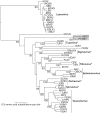Arboretum and Puerto Almendras viruses: two novel rhabdoviruses isolated from mosquitoes in Peru
- PMID: 24421116
- PMCID: PMC3973475
- DOI: 10.1099/vir.0.058685-0
Arboretum and Puerto Almendras viruses: two novel rhabdoviruses isolated from mosquitoes in Peru
Abstract
Arboretum virus (ABTV) and Puerto Almendras virus (PTAMV) are two mosquito-associated rhabdoviruses isolated from pools of Psorophora albigenu and Ochlerotattus fulvus mosquitoes, respectively, collected in the Department of Loreto, Peru, in 2009. Initial tests suggested that both viruses were novel rhabdoviruses and this was confirmed by complete genome sequencing. Analysis of their 11 482 nt (ABTV) and 11 876 (PTAMV) genomes indicates that they encode the five canonical rhabdovirus structural proteins (N, P, M, G and L) with an additional gene (U1) encoding a small hydrophobic protein. Evolutionary analysis of the L protein indicates that ABTV and PTAMV are novel and phylogenetically distinct rhabdoviruses that cannot be classified as members of any of the eight currently recognized genera within the family Rhabdoviridae, highlighting the vast diversity of this virus family.
Figures



References
-
- Allison A. B., Palacios G., Travassos da Rosa A., Popov V. L., Lu L., Xiao S. Y., DeToy K., Briese T., Lipkin W. I. & other authors (2011). Characterization of Durham virus, a novel rhabdovirus that encodes both a C and SH protein. Virus Res 155, 112–122 10.1016/j.virusres.2010.09.007 - DOI - PMC - PubMed
-
- Cybinski D. H., St George T. D., Standfast H. A., McGregor A. (1980). Isolation of Tibrogargan, a new Australian rhabdovirus, from Culicoides brevitarsis. Vet Microbiol 5, 301–308 10.1016/0378-1135(80)90029-2 - DOI
-
- Dietzgen R. G., Calisher C. H., Kurath G., Kuzmin I. V., Rodriguez L. L., Stone D. M., Tesh R. B., Tordo N., Walker P. J. & other authors (2012). Rhabdoviridae. In Virus Taxonomy, Ninth Report of the International Committee on Taxonomy of Viruses, pp. 686–713 Edited by King A. M. Q., Adams M. J., Carstens E. B., Lefkowitz E. J. London: Elsevier/Academic Press
Publication types
MeSH terms
Substances
Associated data
- Actions
- Actions
Grants and funding
LinkOut - more resources
Full Text Sources
Other Literature Sources
Medical
Research Materials

